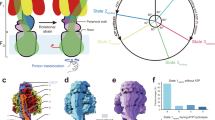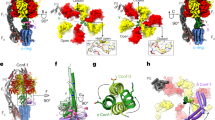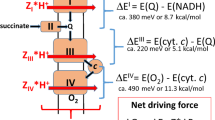Abstract
Mitochondria, bacteria and chloroplasts use the free energy stored in transmembrane ion gradients to manufacture ATP by the action of ATP synthase. This enzyme consists of two principal domains. The asymmetric membrane-spanning Fo portion contains the proton channel, and the soluble F1 portion contains three catalytic sites which cooperate in the synthetic reactions1. The flow of protons through Fo is thought to generate a torque which is transmitted to F1 by an asymmetric shaft, the coiled-coil γ-subunit. This acts as a rotating ‘cam’ within F1, sequentially releasing ATPs from the three active sites1,2,3,4,5. The free-energy difference across the inner membrane of mitochondria and bacteria is sufficient to produce three ATPs per twelve protons passing through the motor. It has been suggested that this protonmotive force biases the rotor's diffusion so that Fo constitutes a rotary motor turning the γ shaft6. Here we show that biased diffusion, augmented by electrostatic forces, does indeed generate sufficient torque to account for ATP production. Moreover, the motor's reversibility — supplying torque from ATP hydrolysis in F1 converts the motor into an efficient proton pump7 — can also be explained by our model.
This is a preview of subscription content, access via your institution
Access options
Subscribe to this journal
Receive 51 print issues and online access
$199.00 per year
only $3.90 per issue
Buy this article
- Purchase on Springer Link
- Instant access to full article PDF
Prices may be subject to local taxes which are calculated during checkout



Similar content being viewed by others
References
Boyer, P. The binding change mechanism for ATP synthase — some probabilities and possibilities. Biochim. Biophys. Acta 1140, 215–250 (1993).
Abrahams, J., Leslie, A., Lutter, R. & Walker, J. Structure at 2.8 Å resolution of F1-ATPase from bovine heart mitochondria. Nature 370, 621–628 (1994).
Fillingame, R. H. Coupling H+ transport and ATP synthesis in F1Fo-ATP synthases: glimpses of interacting parts in a dynamic molecular machine. J. Exp. Biol. 200, 217–224 (1997).
Cross, R. & Duncan, T. Subunit rotation in FoF1-ATP synthases as a means of coupling proton transport through Foto the binding changes in F1. J. Bioenerg. Biomem. 28, 403–408 (1996).
Engelbrecht, S. & Junge, W. ATP synthase: a tentative structural model. FEBS Lett. 414, 485–491 (1997).
Junge, W., Lill, H. & Engelbrecht, S. ATP synthase: An electro-chemical transducer with rotatory mechanics. Trends Biochem. Sci. 22, 420–423 (1997).
Yasuda, R., Noji, H., Kinosita, K., Motojima, F. & Yoshida, M. Rotation of the γ subunit in F1-ATPase; Evidence that ATP synthase is a rotary motor enzyme. J. Bioenerg. Biomem. 29, 207–209 (1997).
Groth, G. & Walker, J. Model of the C-subunit oligomer in the membrane domain of F-ATPases. FEBS Lett. 410, 117–123 (1997).
Dmitriev, O. Y., Altendorf, K. & Fillingame, R. H. Reconstitution of the Focomplex of Escherichia coli ATP synthase from isolated subunits: Varying the number of essential carboxylates by co-incorporation of wild-type and mutant subunit c after purification in organic solvent. Eur. J. Biochem. 233, 478–483 (1995).
Valiyaveetil, F. & Fillingame, R. On the role of Arg 210 and Glu 219 of subunit a in proton translocation by the Escherichia coli FoF1ATP synthase. J. Biol. Chem. (in the press).
Fillingame, R. H., Girvin, M. E. & Zhang, Y. Correlations of structure and function in subunit c of Escherichia coli FoF1ATP synthase. Biochem. Soc. Trans. 23, 760–766 (1995).
Howitt, S., Rodgers, A., Hatch, L., Gibson, F. & Cox, G. The coupling of the relative movement of the a and c subunits of the Foto the conformational changes in the F1-ATPase. J. Bioenerg. Biomem. 28, 415–420 (1996).
Vik, S. B. & Antonio, B. J. Amechanism of proton translocation by F1FoATP synthases suggested by double mutants of the a subunit. J. Biol. Chem. 269, 30364–30369 (1994).
Khan, S. & Berg, H. Isotope and thermal effects in chemiosmotic coupling to the flagellar motor of Streptococcus. Cell 32, 913–919 (1983).
Meister, M., Caplan, S. R. & Berg, H. C. Dynamics of a tightly coupled mechanism for flagellar rotation: Bacterial motility, chemiosmotic coupling, protonmotive force. Biophys. J. 55, 905–914 (1989).
Berg, H. & Khan, S. in Mobility and Recognition in Cell Biology (eds Sund, H. & Veeger, C.) 485–497 (de Gruyter, Berlin, 1983).
Sabbert, D., Engelbrecht, S. & Junge, W. Intersubunit rotation in active F-ATPase. Nature 381, 623–625 (1996).
Fillingame, R. in The Bacteria: A Treatise On Structure And Function (ed. Krulwich, T.) 345–392 (Academic, London, 1990).
Harrison, M., Finbow, M. & Findlay, J. Postulate for the molecular mechanism of the vacuolar H+-ATPase (hypothesis). J. Membr. Biol. 14, 1–3 (1997).
Elston, T. & Oster, G. Protein turbines I: The bacterial flagellar motor. Biophys. J. 73, 703–721 (1997).
Risken, H. The Fokker-Planck Equation (Springer, New York, 1989).
Assadi-Porter, F. & Fillingame, R. Proton-translocating carboxyl of subunit c of F1FoH+-ATP synthase: The unique environment suggested by the pKa determined by 1H NMR. Biochem. 34, 16186–16193 (1995).
Noji, H., Yasuda, R., Yoshida, M. & Kinosita, K. Direct observation of the rotation of F1-ATPase. Nature 386, 299–302 (1997).
Finbow, M. & Harrison, M. The vacuolar H+-ATPase: A universal proton pump of eukaryotes. Biochem. J. 324, 697–712 (1997).
Dimroth, P. Primary sodium ion translocating enzymes. Biochim. Biophys. Acta 1318, 11–51 (1997).
Acknowledgements
We thank C. Peskin, R. Fillingame, W. Junge, H.-P. Moore, J. Walker, R. Cross, and S.Khan for valuable comments. T.E. was suppported by postdoctoral support from Los Alamos National Laboratory, H.W. by a postdoctoral fellowship from National Energy Research Scientific Computing Center, and G.O. by a grant from the NSF.
Author information
Authors and Affiliations
Corresponding author
Supplementary Information
Rights and permissions
About this article
Cite this article
Elston, T., Wang, H. & Oster, G. Energy transduction in ATP synthase. Nature 391, 510–513 (1998). https://doi.org/10.1038/35185
Received:
Accepted:
Issue Date:
DOI: https://doi.org/10.1038/35185
This article is cited by
-
Ion solvation kinetics in bipolar membranes and at electrolyte–metal interfaces
Nature Energy (2024)
-
Bionic iontronics based on nano-confined structures
Nano Research (2023)
-
Molecular dynamics simulation of proton-transfer coupled rotations in ATP synthase FO motor
Scientific Reports (2020)
-
FliI6-FliJ molecular motor assists with unfolding in the type III secretion export apparatus
Scientific Reports (2020)
-
Light polarization dependency existing in the biological photosystem and possible implications for artificial antenna systems
Photosynthesis Research (2020)
Comments
By submitting a comment you agree to abide by our Terms and Community Guidelines. If you find something abusive or that does not comply with our terms or guidelines please flag it as inappropriate.




